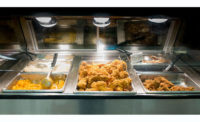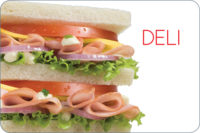Supermarket deli merchandisers seeking to bolster meat and poultry activity must break from tradition.
With sales of bulk meats declining, it is imperative for retailers to liven up selections and branch out from emphasizing historically popular items in the bulk meat case, analysts say.
Revenues for behind-the-glass selections at full-service deli counters totaled $4.8 million for the 52 weeks ending March 24, a 3.2 percent drop versus the year-earlier period, according to Information Resources Inc. (IRI), a Chicago-based market research firm.
The three most popular options — turkey, ham and beef — saw sales declines of 3.7 percent, 3.2 percent and 2.7 percent, respectively, IRI notes.
| Meat | Sales | % Change vs YAgo |
|---|---|---|
| Turkey | $1.7 billion | -3.2% |
| Ham | $1.5 billion | -3.7% |
| Beef | $588 million | -2.7% |
| Chicken | $397 million | $0.9% |
| Salami | $314 million | -2.4% |
| Bologna | $181 million | -0.8% |
Source: Information Resources Inc. (IRI) Market Advantage.
Total U.S. multi-outlet for the 52 weeks ending March 24, 2019.
Contributing to the decline is a dearth of new bulk deli meat varieties, though sales of bulk chicken lunch meat is up about 1 percent as “it is new and novel for some customers,” says Jonna Parker, principal in IRI’s Fresh Center of Excellence.
Even deli lunch meats with health-oriented claims, such as those being developed with no antibiotics or growth hormones, are not generating significant incremental sales, she says.
“There are brands that focus on organic meats or lunch meats with better-for-you claims outside of the deli, such as in the meat department or on the prepackaged wall,” Parker says. “Many consumers that want such products are not necessarily thinking that the selections are available in the deli.”
Changing consumer eating habits also have an impact on deli meat activity, particularly because sandwiches aren’t much of a staple among the large base of Millennials (people typically between the ages of 23 and 38) as the products were for previous generations, says Anne-Marie Roerink, principal of 210 Analytics, a San Antonio-based market research and marketing strategies firm.
Many Millennials instead opt for wraps, bowls, salads and mini meals, she says, adding “relevancy is of utmost importance to reinvigorate sales.”
Some forward-thinking suppliers, however, are moving to boost purchasing by launching more items with novel flavors, spices, seasonings and better-for-you claims, Roerink says.
Cater to the clean-ingredient crowd
Among the health and wellness-oriented options likely to become more prominent are meats developed without the use antibiotics or growth hormones; free of high-fructose corn syrup, nitrites and nitrates; and have lower sodium, she says.
| Meat | Dollar Share | $ Change vs YAgo |
|---|---|---|
| Prosciutto | 6% | $14 million |
| Genoa Salami | 3% | $11 million |
| Hard Salami | 3% | $8 million |
| Salami | 3% | $7 million |
| Pepperoni | 2% | $7 million |
| Beef | 1% | $4 million |
| Assorted Italian | 1% | $3 million |
| Sopressata | 1% | $2 million |
| Summer Sausage | 1% | $1 million |
| Italian Salami | 1% | $219,000 |
| Chicken Breast | 2% | $217,000 |
| Black Forest Ham | 2% | -$1 million |
| Roast Beef | 2% | -$1 million |
| Turkey | 4% | -$2 million |
| Bologna | 7% | -$11 mllion |
| Turkey Breast | 11% | -$15 million |
| Ham | 18% | -$27 million |
Source: Information Resources Inc. (IRI) Market Advantage. Total U.S. multi-outlet for the 52 weeks ending March 24, 2019.
“There is a big push to adapt deli meats to consumer demands for clean labels and additive-free foods,” adds Charles Winship, senior research analyst at Technomic Inc., a Chicago-based food industry research and consulting firm.
Forty-one percent of sandwich buyers, for instance, say natural ingredients are important when deciding which selections to order, Technomic reports in its 2018 Sandwich Consumer Trend Report.
“A growing demand for premium-quality items often means simpler, minimal ingredients on the label,” says Brett Erickson, director of value-added products for the Wooster, Ohio-based Certified Angus Beef brand. “Top quality is an important factor when consumers are deciding which deli meats to purchase.”
Delis, meanwhile, should consider emulating Panera Bread, which has an entire foodservice menu consisting of items that are free of artificial preservatives, sweeteners and flavors, along with an absence of colors from artificial sources, says Jim Wisner, president of Wisner Marketing Group, a Lake Forest, Ill.-based retail consultancy.
“That is the gold standard for the entire food industry and delis need to get to that level,” Wisner says. “Meat offerings in most deli cases do not look a whole lot different than they did 25 years ago. Introducing products that feature fewer ingredients and such claims as ‘nitrate and nitrite free’ is helping brands keep up with healthy eating trends. Being transparent about products is increasingly important.”
Roerink says shoppers are paying “a lot more attention to what is and isn’t in their deli meats, and making that information readily available enables faster decision making.”
Life in the fast lane
Retailers seeking to optimize meat and poultry sales must merchandise proteins that match the specific tastes, lifestyles and interests of myriad shopper segments — and that includes meeting the almost universal desire for convenience.
Sales of bulk meats at full-service deli counters are declining in part because of shoppers’ reluctance to spend excessive time waiting for service, and that is making prepackaged freshly sliced products in grab-and-go cases and online ordering increasingly attractive, analysts say.
Packaging daily the 10 meat and poultry varieties that generate the largest percentage of bulk deli meat sales and offering items of varying thickness will make deli meats more appealing to time-conscious shoppers, says Jim Wisner, president of Wisner Marketing Group, a Lake Forest, Ill.-based retail consultancy.
“Deli operators get hung up thinking that they have to slice the meats only when customers put in requests at the counter, but that can require having shoppers stand in line for 20 minutes waiting to get served and then spending another five minutes waiting for the order to be filled,” he says. “That discourages the many people who don’t want to wait.”
Offering freshly sliced packaged meats in cases also will keep lines at the full-service counter shorter, enabling deli staffers to better attend to the service-oriented shopper, Wisner says.
Sales of pre-sliced meats totaled $3 billion for the 52 weeks ending March 24, up $7.1 percent from the year-earlier period, reports Information Resources Inc. (IRI), a Chicago-based market research firm.
Sixty percent of bulk-meat buyers are also shopping the grab-and-go cases, and 90 percent of grab-and-go trips and dollars are from bulk deli buyers, IRI says, adding that deli grab-and-go revenue shares have doubled over the past three years.
Delis will further benefit by enabling consumers to order meat and poultry selections with their computers or smartphones, pay online and pick up the order at a drive-up window or the curbside service some supermarkets already offer, Wisner says.
Such methods will generate a higher percentage of incremental business and prevent consumers from going elsewhere for carryout selections, he says, noting that carryout growth rates exceed those of sit-down dining at foodservice locations.
In fact, 36 percent of consumers and 45 percent of Millennials indicate they would buy fresh foods online if faster delivery was available, reports IRI.
In addition, 33 percent of consumers and 44 percent of Millennials want fresh foods to be part of grocery in-store pick-up.
“Digital and online ordering and easy pickup for ready-to-eat meats is not being leveraged nearly enough, and especially for younger consumers,” says Jonna Parker, principal of the IRI Fresh Center of Excellence. “Recreating demand for deli meats means doing things besides just having special pricing at the case.”
While Wisner notes that such services “are not that hard” for deli operators to offer, he says that perceived financial risks and inertia from historically selling meat and poultry in traditional ways hold many merchandisers back.
“There are opportunities to rethink the entire process of what the deli is and what it can do,” Wisner says. “Deli operators have not gone as far as they should in making it easier for people to buy and take meats home. There is a huge upside remaining for supermarket delis and they have only scratched the surface.”
— Richard Mitchell
A greater push for prepared foods
Despite the decline in interest, bulk deli meats at full-service counters still account for 62 percent of deli meat dollar sales, while prepacked UPC-coded products generate 25 percent of revenues and fresh-packaged grab-and-go selections account for 13 percent of sales, IRI reports.
Greater vibrancy is occurring in the deli prepared foods sector with sales of meat-based selections up 2.5 percent in 2018 and 1.7 percent in 2017, IRI reports. Yet, the growth rates are much lower than in previous years. Prepared-meat sales grew 4.3 percent in 2016, 8.6 percent in 2015, 7.3 percent in 2014 and 6 percent in 2013, IRI says.
A major cause of the deceleration is the exodus of convenience-minded consumers from full-service deli meat counters, Parker says.
“Shoppers who stand in line at the deli counter might notice chicken pot pies or new pork fried rice items in the prepared area,” Parker says. “But fewer consumers are engaged and many now just pass through the department.”
| Frequency | 2018 | 2017 |
|---|---|---|
| Never | 7% | 6% |
| Every few weeks | 24% | 21% |
| Every week | 30% | 34% |
| Every few days | 11% | 7% |
| Just about every day | 3% | 2% |
Source: The Power of Foodservice at Retail report, 2018
| Year | Growth |
|---|---|
| 2018 | 0.2% |
| 2017 | 0.6% |
| 2016 | 1.5% |
| 2015 | 6.9% |
| 2014 | 4.4% |
| 2013 | 1.9% |
Source: Information Resources Inc. (IRI) Market Advantage, Total Store View + Perimeter, multi-outlet for the data period ending March 24, 2019.
Competition also is affecting deli-prepared food sales, she says, noting most food retailers market such selections as rotisserie or fried chicken, while consumers seeking convenient and more exciting meals also are turning to quick-service restaurants and delivery services.
In response, deli operators should offer options that are more “restaurant like” and have attractive descriptions, says Kelley Fechner, director, customer solutions, for Datassential, a Chicago-based market research firm.
Merchandisers, for instance, can list a pulled pork selection as “Hickory House Pulled Pork Sandwich” and note it is “hot and topped with onion rings and our signature traditional sweet and spicy barbecue sauce on a bakery ciabatta roll,” she says.
The launch of more exciting flavors, such as mango habanero, mojo, maple bourbon and Nashville hot, also can generate greater interest in deli prepared foods, Fechner says.
“There are limited ‘new’ flavors being offered and some delis do not even highlight such attractions even though the flavors can create interest and excitement,” she says.
Fechner adds supermarket delis often have an edge over foodservice outlets because of the availability of fresh ingredients in stores. “All of the new and interesting flavors often are on grocery shelves and retailers should use the items more often in the deli,” Fechner says.
Delis will only have incremental expenses from marketing fresh, high-quality prepared meals or operating food stations with diverse meat and poultry selections because most supermarkets already have the necessary space and ingredients, Wisner says.
“Delis are all offering ribs and chicken, but there are so many more potential choices, such as barbecue and Chinese meals,” he says.
A need for new merchandising schemes
Along with a wider range of protein options, deli merchandisers can spur activity by offering meal deals or discounts, which can include special prices when combining a prepared item, such as rotisserie chicken, with selections from other food departments, Parker says.
“Meal creation that is anchored around prepared meat is compelling,” she says. “Many retailers struggle with that concept, however, because of deli operators wanting to keep all sales in the department. But consumers are willing to look for meal components across the entire store.”
Moving away from the basics also will create more excitement in the bulk meat sector, Wisner says. This may include offering cured or Italian selections, such as salamis and prosciuttos, along with other sliced meats from around the globe.
“It is important to introduce people to items that they may not ordinarily try and that will bring interest and intrigue to the case,” he says. “All the new and incremental volume and margin has to come from varieties that delis are not carrying today.”
Operators can further add allure by marketing limited-time flavors, offering items with novel spices, spotlighting the myriad ways to use proteins in recipes and by situating secondary meat displays throughout stores, such as in the bakery and produce departments, Roerink says.
“Retailers need to bring intentionality, or purpose, back to the deli meat case,” Erickson says. “They should tie sandwiches to national holidays, special occasions and added convenience in the kitchen.”
He notes retailers can highlight deli meats and meal ideas in ads, on social media and through countertop signage. They also can stage in-house sampling of bulk and prepared meats.
“The more we can market deli meats as meal solutions prior to consumers making shopping trips, the more we can ensure the meats are on the grocery list and will be purchased in the store,” Erickson says.
A case for charcuteries
Erickson suggests spotlighting foreign and ethnic meats on charcuterie boards will generate interest from Millennials, noting many of the shoppers are willing to pay more if they are assured of a product’s quality.
Deli operators can use charcuterie board displays to demonstrate the availability of unconventional varieties of deli meats while emphasizing the delis can be attractive destinations for event planning, says Eric Richard, industry relations coordinator for the Madison, Wis.-based International Dairy-Deli-Bakery Association (IDDBA).
“Consumers are becoming more exploratory and experimental and want to try new varieties,” Richard says. “Thinking outside the box and bringing in new types of deli meats — which can be ethnic, international or part of a charcuterie program — is keeping with the times.”
Offering unorthodox meats in deli charcuteries also will likely attract many consumers who typically do not shop the deli, he says.
“Charcuteries are the perfect vehicles for growing sales and increasing traffic in delis,” Richard says, adding that it is important the stations have knowledgeable associates who can share product information. He admits, however, frequent employee turnover and other staffing issues can make it difficult for smaller operators to provide that expertise.
Retailers, meanwhile, can also use social media, message boards and case signage to “tell the story behind the products,” he says.
“That can include mentioning that particular international or exotic meats work well on charcuterie boards or that a product has been produced for 2,000 years,” Richard says. “Consumers want to know the history of their food and how it was created and sourced, and that falls on both the manufacturer and retailer.”
Mountain of youth

Deli operators who turn the relatively passive younger consumer into a powerful meat purchaser will be in position to bolster category activity.
People between the ages of 18 and 34 and singles buy substantially fewer deli meats than older two-person households and retirees, and have powerful purchasing potential, says Jonna Parker, principal in the Fresh Center of Excellence for Information Resources Inc. (IRI), a Chicago-based market research firm.
“This next generation is coming into their full spending power but aren’t very engaged with what deli operators are offering,” she notes.
Such shoppers seek “power foods” with ingredients that are transparent, functional and better for you and more often available in the frozen food aisle, Parker says, adding that delis “are not necessarily meeting consumers’ needs.”
Younger consumers, and especially those who are comfortable with online food ordering and delivery, have an “infinite amount of choices” and show little interest in traditional deli meat offerings, she says.
“If they can choose anything to eat, why would they select the same items that they saw when they were shopping with their moms a decade ago?” Parker asks. “Delis need to reposition to look more like foodservice and make a conscious effort to capture the younger consumer. But it is difficult for large supermarkets that make much of their margin and dollar shares from traditional foods to break away from their established methods.”
Targeting children with prepared deli meats is another important and potentially powerful way to boost department revenues, she says.
“The majority of retailers do not offer anything in the prepared deli specifically for kids, who don’t always eat the same foods as their parents,” Parker says. “The majority of products are designed for the total family or just singles or couples. The refrigerated and frozen cases have many more child-type choices, but the delis that have programs for children are doing well.”
She adds says that child-focused items can include meal deals that center on a sandwich and kid-friendly side dishes, and fun products such as chicken nuggets.
A divergence of tastes
Merchandising meats and prepared foods in accordance with the demographic groups that most frequently shop specific locations also can spark greater activity, analysts say.
Among sandwich buyers, for instance, Millennials (people typically between the ages of 23 and 38) over-index in their purchasing of Caprese Panini, Buffalo Chicken, Torta and Cuban; Generation Xers (people ages 39 to 54) buy more Parmigiana, Heroes and Monte Cristo; and Baby Boomers (people 55 to 73) prefer Heroes, Meatloaf, Reuben and Patty Melts, reports Datassential, a Chicago-based market research.
“Spicy and bold flavors, as well as global inspirations, also have been emerging to appeal to younger consumers,” says Charles Winship, senior research analyst at Technomic, a Chicago-based food industry research and consulting firm.
In addition, delis will benefit from offering strong and iconic brands “that connect with Millennials to the same extent that they did with previous generations,” says Anne-Marie Roerink, principal of 210 Analytics, a San Antonio-based market research and marketing strategies firm.
“Because Millennials under-index for traditional sandwiches, delis have to look for new ways to drive growth,” she says.
— Richard Mitchell
Fear of change remains an issue
Because newer options may initially be slower sellers and generate a larger percentage of shrink, deli operators may be reluctant to launch such selections, Parker says.
“It is tough for delis to justify bringing in unique items that may not sell as fast and risk being thrown away,” she says.
Retailers, however, can better prevent bulk meat shrink by also using the selections in prepared products as well as at food stations, such as the salad bar, which also creates more opportunities to showcase the different uses of meat for home preparation, Erickson says.
Among the newer prepared food applications is the use of roast beef and other deli meats in sushi, which addresses those consumers “who are on the fence about using raw seafood,” Roerink says.
“This plays right into the Millennial playbook and with in-store sampling offers a great opportunity for creating a deli experience and incrementally increasing the chance of a purchase,” she says.
Deli operators also can make meats more enticing by emphasizing such attributes as freshness and protein content and offering selections with trending flavors and ingredients, Richard says.
A “robust” sandwich program, for instance, can utilize bulk meats from delis, breads from in-store bakeries and vegetables from the produce department that were cut that day, he says.
Delis also can benefit by targeting price-conscious shoppers with newer and wider varieties of meats for home meal preparation.
Among people who indicate they are buying fewer sandwiches from foodservice outlets, 56 percent say it’s because it’s more affordable to make sandwiches at home, while 36 percent say it is easier to create sandwiches themselves, Technomic reports.
“Merchandising unique products could help the deli stand out and bring in new traffic,” Richard says. “It is important for retailers to connect to consumers and not be afraid to try new strategies. Younger consumers, including Millennials and Generation Z, are not shopping like their grandparents. They are looking beyond just ham and turkey.” NP






Report Abusive Comment